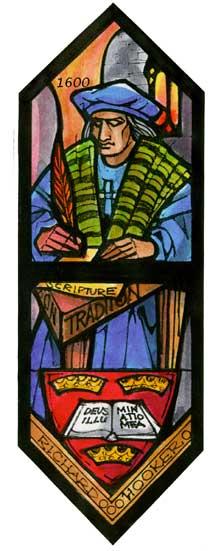|
|
|||

|
|||
Richard Hooker Window
 The upheaval of the 15th century reshaped Europe. The power of the papacy declined as nationalism grew; the fall of Constantinople caused an influx of Greek scholars from Asia, encouraging a return to Biblical and patristic sources; there were advances in mathematics and the sciences; and the printing press came of age, making all of this information readily available. These changes paved the way for the Reformation in the 16th century, which, in England, began during the reign of Henry VIII, but flowered during the reign of his daughter, Elizabeth I, whose policies came to define the Anglican Church. Her “middle way” grounded the Church in Scripture and the most enduring traditions of the Church, while avoiding the excesses of Catholic superstition and Protestant individualism. Richard Hooker was a priest known for his deep convictions, patience, and moderation, and is widely regarded as the greatest theologian of the Anglican Church. His seven-volume work, Of the Laws of Ecclesiastical Polity, gave Anglicanism its philosophical base. Like the other Reformers, Hooker stressed the primacy of Scripture, the subordinate role of tradition, and the use of “sanctified” reason to interpret and apply Scripture.114 He also strove to preserve the ancient traditions of the Church, including the Episcopacy, and especially the form and content of the Book of Common Prayer, which were grounded in the liturgies of the primitive Church. Hooker related Scripture, reason, and tradition (the three sources which modern Episcopalians use as their model of authority) by stating that “obedience is owed primarily to those things which Scripture plainly states; next, to what can be concluded by force of reason; after these, the tradition of the Church follows” (Laws, Book V, 8:2; paraphrased). The Anglican Communion has followed this course for more than 400 years, and Pope Clement VIII expressed that Hooker’s writing “had in it such seeds of eternity that it would abide until the last fire shall consume all learning.” Our window shows Hooker writing at a 3-legged stool, a popular 20th century rendering of the authority of Scripture, reason, and tradition. The stool is shown at an odd angle, representing the ambiguity of the Protestant/Catholic tension in the Book of Common Prayer. Hooker’s education and fellowship at Oxford are highlighted with the university’s seal, which also represents Godly learning. The lamp represents the light of knowledge.
Like Stars Appearing: The Story of the Stained Glass
Windows of St. George's Episcopal Church, Dayton, Ohio | |||
|
|||
